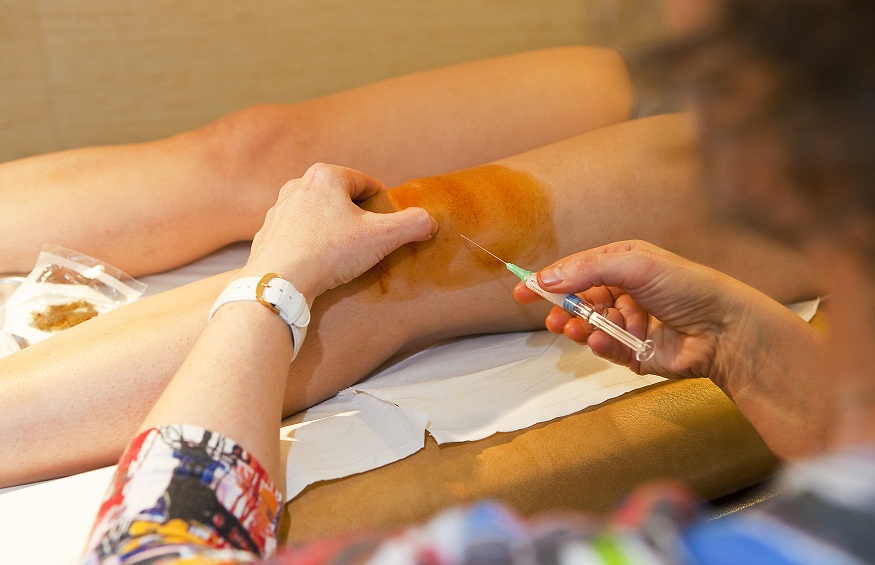Cortisone injections are used to treat a variety of conditions that can affect the upper limb. These conditions can include, but are not limited to, arthritis, carpal tunnel syndrome , Dupuytren’s contracture , tendonitis, tennis elbow, etc. Cortisone injections are widely used in the treatment of many joint and soft tissue conditions affecting the legs, feet, hips, and other parts of the body.
Cortisone injections relieve patients of their symptoms, but like any medication, they are not without risks and inconveniences. Your doctor may use cortisone injections as part of a larger treatment plan or sometimes to confirm a diagnosis.
What there is to know
Before treatment, your doctor should be informed of any pre-existing conditions and any medications you are currently taking. Some drugs can interact with cortisone injections.
Anticoagulants are one example. Patients on anticoagulants should stop taking their medication several days before the injection to avoid excessive bleeding and bruising.
If you have had a fever of at least 100.4 F in the two weeks before the injection, your doctor may ask you to wait to receive your injection.
Patients who are pregnant, breastfeeding, have certain mental illnesses or have recently been vaccinated may not be advised to receive cortisone injections.
If you are not relieved by the cortisone injections after 24 to 48 hours, you should tell your doctor. Serious side effects are rare, but if you are concerned you should also contact your doctor.
Ultrasound-guided injections should be preferred when available. Using an ultrasound makes it possible to pinpoint the precise location of the pain and inject the medication there. It also helps to avoid the unwanted complications of injecting the drug in the wrong place.
The benefits of cortisone injections
Cortisone injections are standard treatment for inflammation that causes severe pain and discomfort in patients. These injections should always be administered by qualified doctors to minimize the risks. The benefits of cortisone injections are as follows:
Cortisone injections can be used as a diagnostic tool. They can help confirm the exact source of the pain and rule out the possibility of another, potentially more serious condition.
Injections provide faster, more localized pain relief than conventional anti-inflammatory drugs.
Most patients experience few or no side effects after the injection.
The injection can be done with little or no discomfort.
The disadvantages of cortisone injections
So cortisone injections are not without problems. Besides the usual side effects, cortisone injections have other disadvantages:
Cortisone injections only provide temporary relief. Without further treatment, the condition is likely to get worse over time.
Cortisone injections can also mask symptoms. This can lead a patient to believe that their condition is improving, when it could in fact deteriorate.
Cortisone injections can only be done every six weeks, sometimes even less. Indeed, these injections can damage the cartilage of a joint or deteriorate the tendons in the injected area.
Repeated use of cortisone injections can also mask irreversible nerve damage that will need to be treated with surgery.
Cortisone injections weaken the immune system and reduce the body’s ability to fight infections. If you are already compromised
Cortisone injections as a treatment plan
Cortisone injections should only be part of a larger treatment plan for a particular condition. The effects of cortisone injections are temporary, and prolonged use may cause further damage. Patients seeking long-term relief may be advised:
Lose excess weight
Being overweight can put stress on the joints. Losing weight can make the effects of cortisone injections stronger and last longer.
Undertake physiotherapy or occupational therapy treatment
Stretching and strengthening the affected muscles, as well as the surrounding muscles, can help prevent further damage and improve the patient’s condition.
Some therapists may also use massage techniques and other means to reduce inflammation.
Lifestyle changes
Diet and exercise, as well as changes in your daily routine can help reduce inflammation and improve your condition.
What is a cortisone surge
A cortisone surge , sometimes called a steroid surge, is a common side effect of cortisone injections.
Pain normally begins to appear 24 to 48 hours after the injection. Cortisone surges can be easily managed by freezing the inflamed area and taking over-the-counter medications like ibuprofen or acetaminophen.




